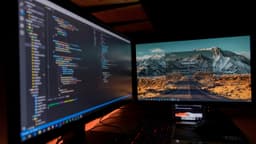What is Deep Learning with Python?
Deep learning is a subfield of machine learning focused on training artificial neural networks to learn from data and make predictions or decisions. This approach effectively solves complex problems. Python, with its extensive libraries and frameworks, has become the preferred programming language for implementing deep learning algorithms.
Understanding Deep Learning
What is the basis of deep learning? It is inspired by the structure and function of the human brain. Deep learning mimics the communication and learning processes of neurons. Models consist of multiple layers of artificial neurons, known as artificial neural networks. These networks learn and extract meaningful patterns from raw data automatically.
Deep learning is effective with large datasets and complex tasks. Common applications include image recognition, natural language processing, speech recognition, and autonomous driving. It often outperforms traditional machine learning techniques in accuracy and performance.
Python for Deep Learning
Why choose Python for deep learning? It offers a rich ecosystem of libraries and frameworks that simplify the implementation of deep learning algorithms. Some popular libraries include:
-
TensorFlow: Developed by Google, TensorFlow is a powerful open-source library for numerical computation and deep learning. It includes a high-level API called Keras for rapid prototyping and experimentation with neural networks.
-
PyTorch: Created by Facebook's AI research lab, PyTorch is widely used for deep learning. It features dynamic computational graphs, providing flexibility for research and development.
-
Keras: Keras is a user-friendly library that runs on TensorFlow or Theano. It offers an intuitive API for building and training neural networks.
-
Scikit-learn: Primarily a machine learning library, scikit-learn has tools and algorithms for deep learning as well. It offers a straightforward interface for building neural networks and preprocessing data.
To begin with deep learning in Python, install the necessary libraries and frameworks using the Python package manager, pip. Here is an example to install TensorFlow:
Markdown
After installation, you can import the libraries into your Python script and start building and training neural networks.
External Resources
Here are some resources to help you explore deep learning with Python:
-
Deep Learning with Python: A book by François Chollet, the creator of Keras, providing a comprehensive introduction to deep learning concepts and practical examples using Python and Keras.
-
TensorFlow Tutorials: The official TensorFlow website offers tutorials and guides to help you learn and implement deep learning models.
-
PyTorch Documentation: The official PyTorch documentation provides tutorials, examples, and API references for building deep learning models.
These resources provide a solid foundation and hands-on experience with Python-based deep learning tools and frameworks.
Deep learning offers powerful solutions to complex problems by training artificial neural networks. Python's extensive libraries make it an excellent platform for implementing deep learning algorithms.
(Edited on September 4, 2024)












